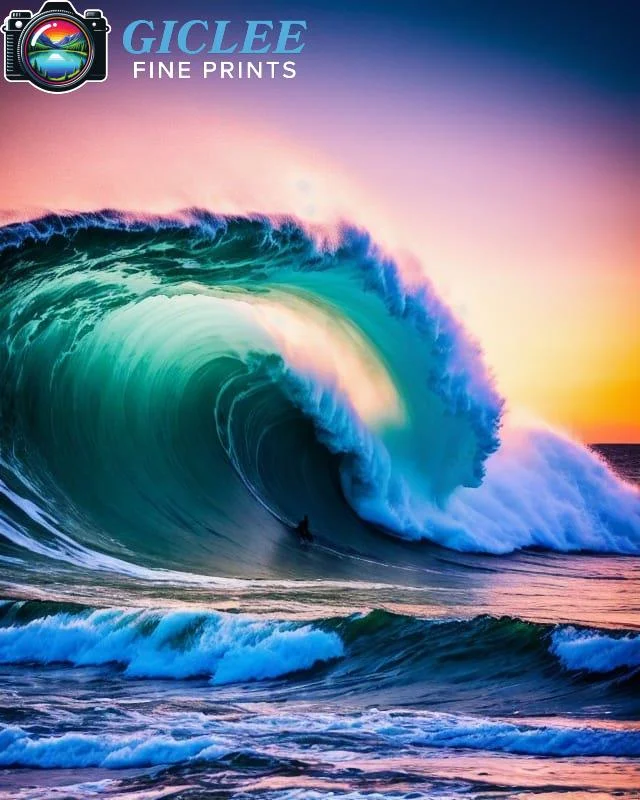
When selecting a canvas for your artwork or prints, you’re often faced with the choice between stretched canvas and canvas panels. Both are popular options for artists and art collectors alike, but they differ in terms of structure, durability, and usage. Understanding the key differences between stretched canvas and canvas panels will help you choose the right option for your artistic or display needs. At Giclee Fine Prints, we offer expert advice and high-quality prints on both mediums.
Structure and Build
The main difference between stretched canvas and canvas panels lies in their structure and how they are prepared for use.
Stretched Canvas:
- Stretched Over a Wooden Frame: Stretched canvas is made by stretching a piece of canvas fabric over a wooden stretcher bar frame, then tightly securing it at the back. This creates a sturdy, flat surface that is ready for painting or printing.
- Gallery-Wrapped Option: The edges of a stretched canvas can be left blank or painted, but a popular option is the gallery wrap, where the image wraps around the sides of the canvas for a frameless, modern look.
- Three-Dimensional Depth: Due to the wooden frame, stretched canvases have depth, which makes them stand out from the wall and gives them a more substantial, professional appearance.
Canvas Panels:
- Canvas Mounted on a Rigid Board: Canvas panels are made by adhering a piece of canvas fabric to a rigid board or panel, such as MDF or cardboard. The canvas is glued or stapled onto the surface, providing a flat and stable platform for painting or printing.
- Slim and Compact: Unlike stretched canvas, canvas panels are much thinner, with no frame or visible depth. They are lightweight and compact, making them easy to transport or store.
- No Flexibility: Since the canvas is glued to a solid backing, canvas panels do not have the same flexibility as stretched canvases, which are slightly springy when touched.
Best For:
- Stretched Canvas: Ideal for large, frameless artwork or prints that require a professional, gallery-style presentation.
- Canvas Panels: Perfect for smaller works, studies, or projects where portability and cost-effectiveness are priorities.
Durability and Longevity
Both stretched canvas and canvas panels are durable options, but their longevity depends on how they are used and displayed.
Stretched Canvas:
- Long-Lasting: Stretched canvas is designed to last for decades, especially when made with high-quality canvas and archival inks. The frame provides structural support, helping the canvas maintain its tension and preventing sagging over time.
- Resistant to Warping: When stretched properly, the wooden stretcher bars provide excellent support, keeping the canvas flat and resistant to warping. Gallery-wrapped canvases are particularly durable because they don’t require additional framing, which reduces exposure to environmental damage.
- Prone to Punctures: While durable, stretched canvas can be prone to punctures or dents if mishandled, especially in high-traffic areas.
Canvas Panels:
- Rigid and Durable: Since canvas panels are mounted on a solid backing, they are less prone to punctures or dents compared to stretched canvas. The rigid surface protects the canvas and keeps it intact.
- Potential for Warping: While canvas panels are durable, the backing can sometimes warp, especially if exposed to moisture or extreme temperature changes. High-quality, acid-free panels reduce this risk.
- Best for Temporary Use: Canvas panels are generally not as long-lasting as stretched canvases and are often used for studies, practice, or temporary displays. However, high-quality panels can still last for years when properly cared for.
Best For:
- Stretched Canvas: Excellent for long-term display and artwork meant to last for generations.
- Canvas Panels: Great for projects that require durability on a budget or for temporary or portable displays.

Cost and Affordability
The cost of stretched canvas and canvas panels can vary depending on the quality, size, and materials used. However, canvas panels tend to be more affordable.
Stretched Canvas:
- Higher Initial Cost: The cost of a stretched canvas is generally higher than that of canvas panels because of the wooden stretcher bars, the labor involved in stretching, and the quality of the canvas itself. Larger sizes of stretched canvas increase in price significantly due to the materials required.
- Long-Term Investment: While the initial cost is higher, stretched canvas is a long-term investment that offers excellent durability and professional presentation, reducing the need for additional framing.
Canvas Panels:
- Budget-Friendly: Canvas panels are more affordable than stretched canvas because they don’t require a wooden frame and are easier to produce. They are ideal for artists or buyers on a budget who still want the feel of canvas.
- Great for Practice or Studies: Due to their low cost, canvas panels are often used by artists for practice pieces, studies, or preliminary sketches before committing to a stretched canvas.
Best For:
- Stretched Canvas: Best for artists or collectors looking to invest in high-quality, long-lasting pieces for professional display.
- Canvas Panels: Ideal for beginners, students, or artists working on a budget, as well as those looking for temporary solutions.
Display and Framing Options
How you plan to display your artwork can also influence your choice between stretched canvas and canvas panels.
Stretched Canvas:
- Ready to Hang: One of the main advantages of stretched canvas is that it’s ready to hang as soon as it’s finished. The gallery-wrapped option provides a frameless look that is modern and professional, eliminating the need for additional framing.
- Framing Optional: If desired, stretched canvas can be framed for a more traditional or decorative look. However, many artists and collectors prefer the frameless display.
- Three-Dimensional Presence: The depth of the stretcher bars gives the artwork a three-dimensional presence, making it stand out from the wall.
Canvas Panels:
- Requires Framing: Since canvas panels are flat and have no depth, they often need to be framed for display. Framing not only enhances the aesthetic appeal but also protects the panel from environmental damage.
- Portable and Easy to Transport: Due to their slim profile, canvas panels are easy to transport, making them ideal for artists who travel or need to ship artwork frequently. However, they lack the immediate, ready-to-hang appeal of stretched canvas.
Best For:
- Stretched Canvas: Ideal for those who want a ready-to-hang piece with a frameless, contemporary look.
- Canvas Panels: Best for artists or collectors who prefer to choose custom frames for their artwork or need a lightweight, portable option.

Weight and Portability
The weight and portability of stretched canvas versus canvas panels can be a deciding factor, especially for artists working on large pieces or needing to transport their work.
Stretched Canvas:
- Heavier and More Substantial: Stretched canvases are heavier than canvas panels due to the wooden stretcher bars. While this adds to the durability and professional look, it can make larger pieces more difficult to transport or hang.
- Challenging for Large Projects: For artists working on very large canvases, the weight and bulk of stretched canvas can be challenging, especially if the artwork needs to be moved frequently.
Canvas Panels:
- Lightweight and Portable: Canvas panels are much lighter and more compact, making them easy to transport and store. This is a significant advantage for artists who need to bring their work to shows, galleries, or classes.
- Easier to Handle: The lightweight nature of canvas panels makes them easier to handle, especially for smaller works or studies.
Best For:
- Stretched Canvas: Ideal for static displays or installations where weight isn’t an issue.
- Canvas Panels: Perfect for artists on the go or those who need a lightweight, portable option for travel or exhibitions.
Contact Us
Our address is: 3816 Pioneer Trail Ste #3, South Lake Tahoe, CA 96150
Email: Info@gicleefineprints.com
FAQs
Both are great for painting, but stretched canvas offers a more professional, durable option for long-term artwork, while canvas panels are ideal for practice or more affordable projects.
Yes, stretched canvas can be framed for a more traditional look, though many prefer the frameless gallery wrap style for a contemporary display.
Canvas panels are durable and resistant to punctures, but they may warp over time if not cared for properly. High-quality, acid-free panels reduce this risk.


